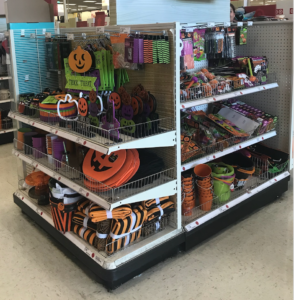 Each summer as I desperately cling to what sunshine and warm temperature is left of the season, the nearby department store always has a way to remind me that indeed, fall is coming. It’s a trend I notice in the middle of each summer; a trend I dread each time. You all know what I am referring to – it’s a hot August day, and even the walk into the store has you eagerly anticipating its refreshing AC. With that, you’re greeted by goblins, witches and skeletons, and suddenly you forget what month it is. It (literally) creeps up on you like a ghost.
Each summer as I desperately cling to what sunshine and warm temperature is left of the season, the nearby department store always has a way to remind me that indeed, fall is coming. It’s a trend I notice in the middle of each summer; a trend I dread each time. You all know what I am referring to – it’s a hot August day, and even the walk into the store has you eagerly anticipating its refreshing AC. With that, you’re greeted by goblins, witches and skeletons, and suddenly you forget what month it is. It (literally) creeps up on you like a ghost.
As the years go by, the earlier it seems my summers are ending due to early-Halloween marketing. And when I take a look back at the year in full, it’s like I’m wishing it away as I am constantly reminded of the next best holiday, forced to be living in the future rather than the present. As a consumer, I began wondering why exactly brands might begin marketing so early, and what they could do to generate more excitement (and sales) surrounding premature holiday marketing.
- Provide deals. Let’s be real. I am already annoyed that stores are practically forcing me to accept an early end to summer as I stand surrounded by fall décor. The last thing I want to do is pay for decorations that will sit around in storage for months, let alone pay full price. In order to market to consumers to buy holiday products prior to its appropriate season, a deal is necessary. I’m not saying products should go on a ridiculous sale the moment of their release, but rather have some type of special to easily appeal to consumers who are not typically looking to buy holiday products so early. No matter what time of the year, a little BOGO goes a long way.
- Offer useful products. It’s August. Personally, I have no interest in hanging a ghoul on my front door or sporting a witch costume around town. Instead, brands can market products broad enough to use in the late summer or early fall. For example, decorations that symbolize the changing of the seasons: different colored leaves, pumpkins or even scarecrows. This makes it less seeming that your brand is marketing Halloween, leaving a more open-ended opportunity for your consumers to buy into.
- Know your audience. As a young adult with no kids, I personally do not have a reason to prepare for Halloween. Typically, my Halloween consists of a last-minute costume decision and a hurriedly-scheduled plan. Parents, however, tend to be much busier with more extensive planning to do for their one-or-more children. Marketing more child-specific products, especially costumes, are likely to get a better turn out than adult products marketed to those who likely are not thinking about Halloween until way later in the game.
Like marketing for any holiday, brands love to start a little too soon. But as consumers, we often become overwhelmed and discouraged with the amount of product we see at such an early time. In order to overcome these obstacles, brands can take different approaches with their consumers to increase sales and meet goals.


